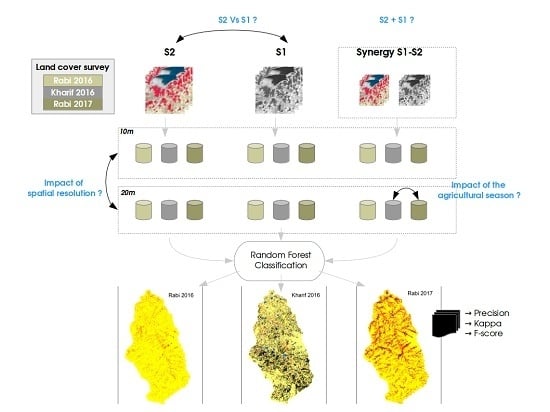Detection of Irrigated Crops from Sentinel-1 and Sentinel-2 Data to Estimate Seasonal Groundwater Use in South India
Abstract
:1. Introduction
2. Materials and Methods
2.1. Study Area
2.2. Sentinel-1 and 2 Datasets
2.2.1. Sentinel-1 and 2 Pre-Processing
2.2.2. Sentinel Bands and Derived Indexes
2.3. Field Data from Land Cover Surveys in 2016 and 2017
2.4. Irrigated Crop Classification Methods and Strategy
2.4.1. Random Forest Supervised Classification
2.4.2. Training and Validation Dataset
2.4.3. Evaluation of Land-Cover Data
2.4.4. Estimation of Irrigated Water Demand (IWD)
2.5. Surface Water from Sentinel-1 Time Series
3. Results
3.1. Hydro-Climatic Context during the Three Studied Growing Seasons
3.2. Random Forest Crop Detection Accuracy
3.2.1. Precision of Irrigated Crop Detection
3.2.2. Detection of Non-Irrigated Areas
3.3. Retrieval of Agro-Hydrological Variables
3.3.1. Estimation of Irrigated Areas and the Uncertainty of Water Demand Quantification
3.3.2. The Uncertainty of Irrigated Water Demand Quantification
3.4. Surface Water Area Dynamics Using the S1 Dataset
4. Discussion
4.1. Accuracy of Essential Variable Restitution Methods
4.1.1. Irrigated Water Demand Restitution
4.1.2. Surface Water Area Dynamics
4.1.3. Effect of Spatial Resolution
4.2. Farmers’ Adaptation and Vulnerability to Climate Variability
4.2.1. Short-Term Variations in Climate and IWD
4.2.2. The Indian Agriculture, Groundwater, and Energy Nexus
4.3. The Adaptation of Farmers’ Irrigation Reasoning and Practices to Climatic Variability
5. Conclusions
Acknowledgments
Author Contributions
Conflicts of Interest
References
- Hazell, P.B.R. The Green Revolution Reconsidered; International Food Policy Research Institute: Washington, DC, USA, 1991. [Google Scholar]
- Shah, T. Climate change and groundwater: India’s opportunities for mitigation and adaptation. Environ. Res. Lett. 2009, 4, 035005. [Google Scholar] [CrossRef]
- Mall, R.K.; Gupta, A.; Singh, R.; Singh, R.S.; Rathore, L.S. Water resources and climate change: An Indian perspective. Curr. Sci. 2006, 90, 1610–1626. [Google Scholar]
- Wada, Y.; Van Beek, L.P.H.; Bierkens, M.F.P. Nonsustainable groundwater sustaining irrigation: A global assessment. Water Ressour. Res. 2012, 48. [Google Scholar] [CrossRef]
- Siebert, S.; Burke, J.; Faures, J.M.; Frenken, K.; Hoogeveen, J.; Döll, P.; Portmann, F.T. Groundwater use for irrigation—A global inventory. Hydrol. Earth Syst. Sci. 2010, 14, 1863–1880. [Google Scholar] [CrossRef] [Green Version]
- Rodell, M.; Velicogna, I.; Famiglietti, J.S. Satellite-based estimates of groundwater depletion in India. Nature 2009, 460, 999–1002. [Google Scholar] [CrossRef] [PubMed]
- Tiwari, V.M.; Wahr, J.; Swenson, S. Dwindling groundwater resources in northern India, from satellite gravity observations. Geophys. Res. Lett. 2009, 36, L18401. [Google Scholar] [CrossRef]
- Asoka, A.; Gleeson, T.; Wada, Y.; Mishra, V. Relative contribution of monsoon precipitation and pumping to changes in groundwater storage in India. Nat. Geosci. 2017, 10, 109–117. [Google Scholar] [CrossRef]
- Sishodia, R.P.; Shukla, S.; Graham, W.D.; Wani, S.P.; Garg, K.K. Bi-decadal groundwater level trends in a semi-arid south indian region: Declines, causes and management. J. Hydrol. Reg. Stud. 2016, 8, 43–58. [Google Scholar] [CrossRef]
- Tiwari, V.M.; Wahr, J.M.; Swenson, S.; Singh, B. Land water storage variation over Southern India from space gravimetry. Curr. Sci. 2011, 101, 536–540. [Google Scholar]
- Bonsor, H.C.; MacDonald, A.M.; Ahmed, K.M.; Burgess, W.G.; Basharat, M.; Calow, R.C.; Dixit, A.; Foster, S.S.D.; Gopal, K.; Lapworth, D.J.; et al. Hydrogeological typologies of the Indo-Gangetic basin alluvial aquifer, South Asia. Hydrogeol. J. 2017, 25, 1–30. [Google Scholar] [CrossRef]
- Mukherjee, A.; Saha, D.; Harvey, C.F.; Taylor, R.G.; Ahmed, K.M.; Bhanja, S.N. Groundwater systems of the Indian Sub-Continent. J. Hydrol. Reg. Stud. 2015, 4, 1–14. [Google Scholar] [CrossRef]
- Kumar, K.K.; Rajagopalan, B.; Hoerling, M.; Bates, G.; Cane, M. Unraveling the mystery of Indian monsoon failure during El Niño. Science 2016, 314, 115–119. [Google Scholar] [CrossRef] [PubMed]
- Pervez, M.S.; Henebry, G.M. Differential heating in the Indian Ocean differentially modulates precipitation in the Ganges and Brahmaputra Basins. Remote Sens. 2016, 8, 901. [Google Scholar] [CrossRef]
- Perrin, J.; Ferrant, S.; Massuel, S.; Dewandel, B.; Maréchal, J.C.; Aulong, S.; Ahmed, S. Assessing water availability in a semi-arid watershed of southern India using a semi-distributed model. J. Hydrol. 2012, 460–461, 143–155. [Google Scholar] [CrossRef]
- Shah, T.; Giordano, M.; Mukherji, A. Political economy of the energy-groundwater nexus in India: Exploring issues and assessing policy options. Hydrogeol. J. 2012, 20, 995–1006. [Google Scholar] [CrossRef]
- Ferrant, S.; Caballero, Y.; Perrin, J.; Gascoin, S.; Dewandel, B.; Aulong, S.; Dazin, F.; Ahmed, S.; Maréchal, J.C. Projected impacts of climate change on farmers’ extraction of groundwater from crystalline aquifers in South India. Sci. Rep. 2014, 4, 1377–1406. [Google Scholar] [CrossRef] [PubMed]
- Dewandel, B.; Caballero, Y.; Perrin, J.; Boisson, A.; Dazin, F.; Ferrant, S.; Chandra, S.; Maréchal, J.C. A methodology for regionalizing 3-D effective porosity at watershed scale in crystalline aquifers. Hydrol. Process. 2017, 31, 2277–2295. [Google Scholar] [CrossRef]
- Massuel, S.; Perrin, J.; Wajid, M.; Mascre, C.; Dewandel, B. A simple low-cost method to monitor duration of ground water pumping. Ground Water 2008, 47, 141–145. [Google Scholar] [CrossRef] [PubMed]
- Arnold, J.G.; Srinivasan, R.; Muttiah, R.S.; Williams, J.R. Large-area hydrologic modeling and assessment: Part I. Model development. J. Am. Water Ressour. Assoc. 1998, 34, 73–89. [Google Scholar] [CrossRef]
- Inglada, J.; Vincent, A.; Arias, M.; Marais-Sicre, C. Improved early crop type identification by joint use of high temporal resolution SAR and optical image time series. Remote Sens. 2016, 8, 362. [Google Scholar] [CrossRef]
- Sylvain, F.; Yann, K.; Ahmad, A.B.; Michel, L.P.; Adrien, S.; Stephane, M.; Alexandre, B.; Jean-Christophe, M.; Sat, T.; Muddu, S.; et al. Synergetic use of Sentinel-1 and 2 to improve agro-hydrological modeling preliminary results on rice paddy detection in South-India. In Proceedings of the ESA Living Planet Symposium, Prague, Czech Republic, 9–13 May 2016. [Google Scholar]
- Pelletier, C.; Valero, S.; Inglada, J.; Champion, N.; Dedieu, G. Assessing the robustness of Random Forests to map land cover with high resolution satellite image time series over large areas. Remote Sens. Environ. 2016, 187, 156–168. [Google Scholar] [CrossRef]
- Dewandel, B.; Perrin, J.; Ahmed, S.; Aulong, S.; Hrkal, Z.; Lachassagne, P.; Samad, M.; Massuel, S. Development of a tool for managing groundwater resources in semi-arid hard-rock regions. Application to a rural watershed in South India. Hydrol. Process. 2010, 24, 2784–2797. [Google Scholar] [CrossRef]
- Rajeevan, M.; Bhate, J. A high resolution gridded rainfall dataset (1971–2005) for mesoscale meteorological studies. Curr. Sci. 2009, 4, 558–562. [Google Scholar]
- Massuel, S.; Perrin, J.; Mascre, C.; Mohamed, W.; Boisson, A.; Ahmed, S. Managed aquifer recharge in South India: What to expect from small percolation tanks in hard rock? J. Hydrol. 2014, 512, 157–167. [Google Scholar] [CrossRef]
- Sivaprasad, P.; Babu, C.A. Seasonal variation and classification of aerosols over an inland station in India. Meteorol. Appl. 2014, 21, 241–248. [Google Scholar] [CrossRef]
- Bruniquel, J.; Lopes, A. Multi-variate optimal speckle reduction in SAR imagery. Int. J. Remote Sens. 1997, 18, 603–627. [Google Scholar] [CrossRef]
- Mermoz, S.; le Toan, T. Forest disturbances and regrowth assessment using ALOS PALSAR data from 2007 to 2010 in Vietnam, Cambodia and Lao PDR. Remote Sens. 2016, 8, 217. [Google Scholar] [CrossRef]
- Mermoz, S.; Le Toan, T.; Villard, L.; Réjou-Méchain, M.; Seifert-Granzin, J. Biomass assessment in the Cameroon savanna using ALOS PALSAR data. Remote Sens. Environ. 2014, 155, 109–119. [Google Scholar] [CrossRef]
- Lee, J.-S. Speckle suppression and analysis for synthetic aperture radar images. Opt. Eng. 1986, 25, 255636. [Google Scholar] [CrossRef]
- Huete, A.; Miura, T.; Yoshioka, H.; Ratana, P.; Broich, M. Indices of vegetation activity. In Biophysical Applications of Satellite Remote Sensing; Hanes, J.M., Ed.; Springer: Berlin/Heidelberg, Germany, 2014; pp. 1–41. [Google Scholar]
- Gao, B. NDWI—A normalized difference water index for remote sensing of vegetation liquid water from space. Remote Sens. Environ. 1996, 58, 257–266. [Google Scholar] [CrossRef]
- Alexandridis, T.K.; Zalidis, G.C.; Silleos, N.G. Mapping irrigated area in Mediterranean basins using low cost satellite Earth Observation. Comput. Electron. Agric. 2008, 64, 93–103. [Google Scholar] [CrossRef]
- Breiman, L. Random Forests. Mach. Learn. 2001, 45, 5–32. [Google Scholar] [CrossRef]
- Dewandel, B.; Gandolfi, J.M.; Zaidi, F.K.; Ahmed, S.; Subrahmanyam, K. A decision support tool with variable agro-climatic scenarios for sustainable groundwater management in semi-arid hard rock areas. Curr. Sci. 2007, 92, 1093–1102. [Google Scholar]
- Cazals, C.; Rapinel, S.; Frison, P.L.; Bonis, A.; Mercier, G.; Mallet, C.; Corgne, S.; Rudant, J.P. Mapping and characterization of hydrological dynamics in a coastal marsh using high temporal resolution Sentinel-1A images. Remote Sens. 2016, 8, 570. [Google Scholar] [CrossRef]
- Maréchal, J.C.; Dewandel, B.; Subrahmanyam, K. Use of hydraulic tests at different scales to characterize fracture network properties in the weathered-fractured layer of a hard rock aquifer. Water Resour. Res. 2004, 40. [Google Scholar] [CrossRef]
- Boisson, A.; Baisset, M.; Alazard, M.; Perrin, J.; Villesseche, D.; Dewandel, B.; Kloppmann, W.; Chandra, S.; Picot-Colbeaux, G.; Sarah, S.; et al. Comparison of surface and groundwater balance approaches in the evaluation of managed aquifer recharge structures: Case of a percolation tank in a crystalline aquifer in India. J. Hydrol. 2014, 519, 1620–1633. [Google Scholar] [CrossRef]
- Fishman, R.M.; Siegfried, T.; Raj, P.; Modi, V.; Lall, U. Over-extraction from shallow bedrock versus deep alluvial aquifers: Reliability versus sustainability considerations for India’s groundwater irrigation. Water Resour. Res. 2011, 47, W00L05. [Google Scholar] [CrossRef]
- Janssen, M.A.; Ostrom, E. Chapter 30 governing social-ecological systems. Handb. Comput. Econ. 2006, 2, 1465–1509. [Google Scholar]
- Parker, D.C.; Manson, S.M.; Janssen, M.A.; Hoffmann, M.J.; Deadman, P. Multi-agent systems for the simulation of land-use and land-cover change: A review. Ann. Assoc. Am. Geogr. 2003, 93, 314–337. [Google Scholar] [CrossRef]
- Bommel, P. Définition d’un Cadre Méthodologique pour la Conception de Modèles Multi-Agents Adaptée à la Gestion des Ressources Renouvelables. Ph.D. Thesis, Université Montpellier II—Sciences et Techniques du Languedoc, Montpellier, France, 2009. [Google Scholar]
- Saqalli, M.; Bielders, C.L.; Gerard, B.; Defourny, P. Simulating rural environmentally and socio-economically constrained multi-activity and multi-decision societies in a low-data context: A challenge through empirical agent-based modeling. J. Artif. Soc. Soc. Simul. 2009, 13, 1. [Google Scholar] [CrossRef]


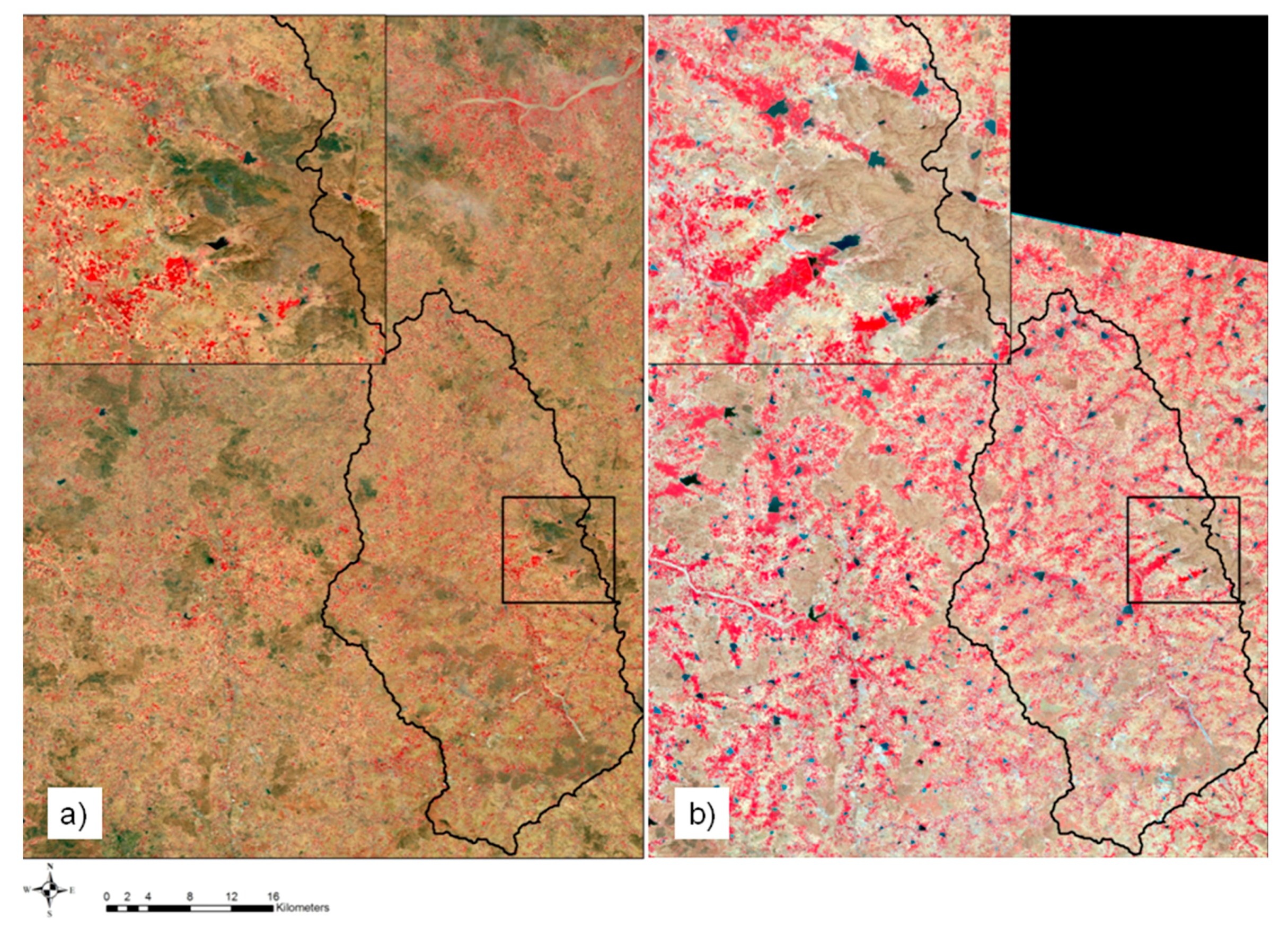
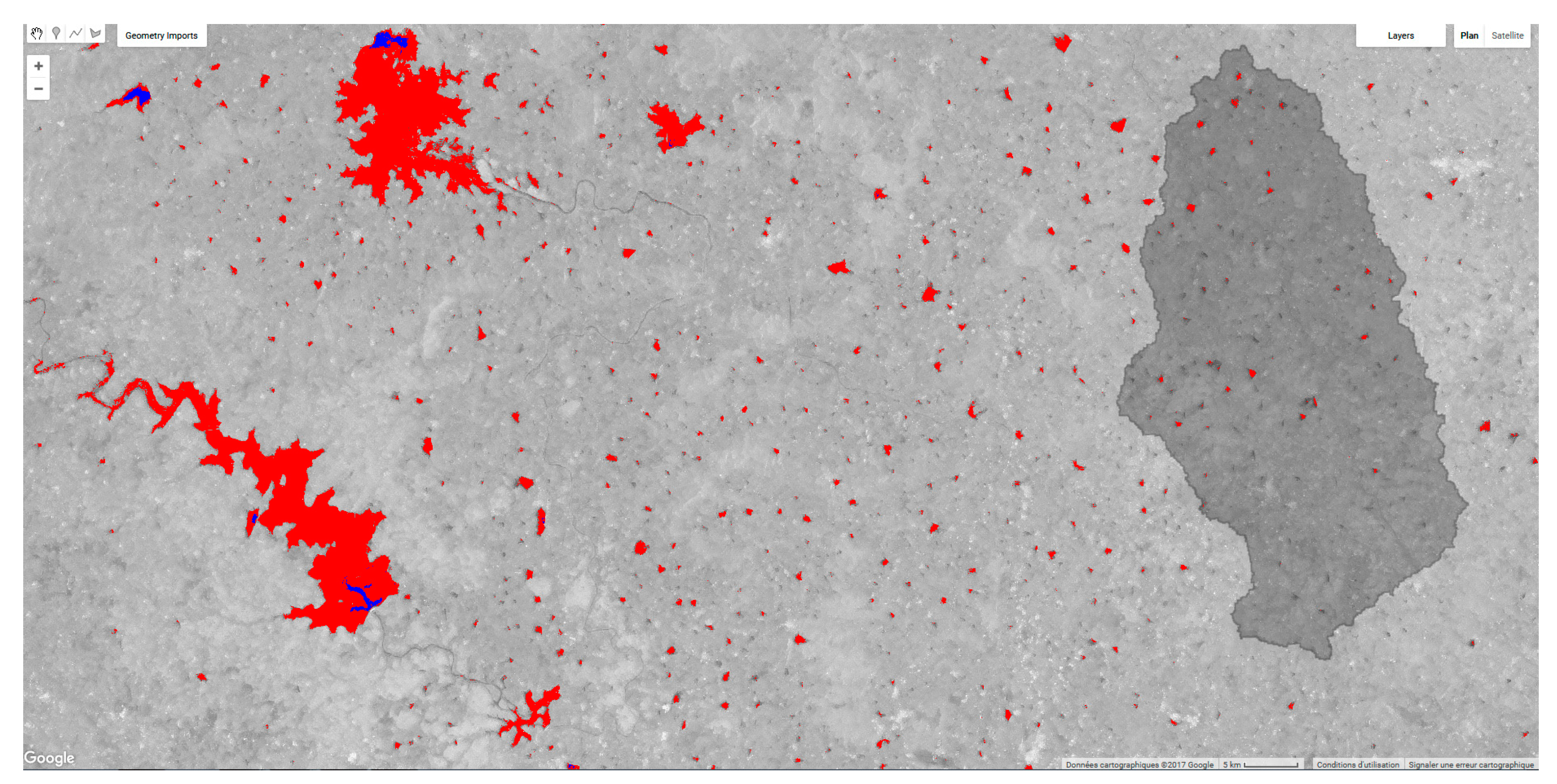
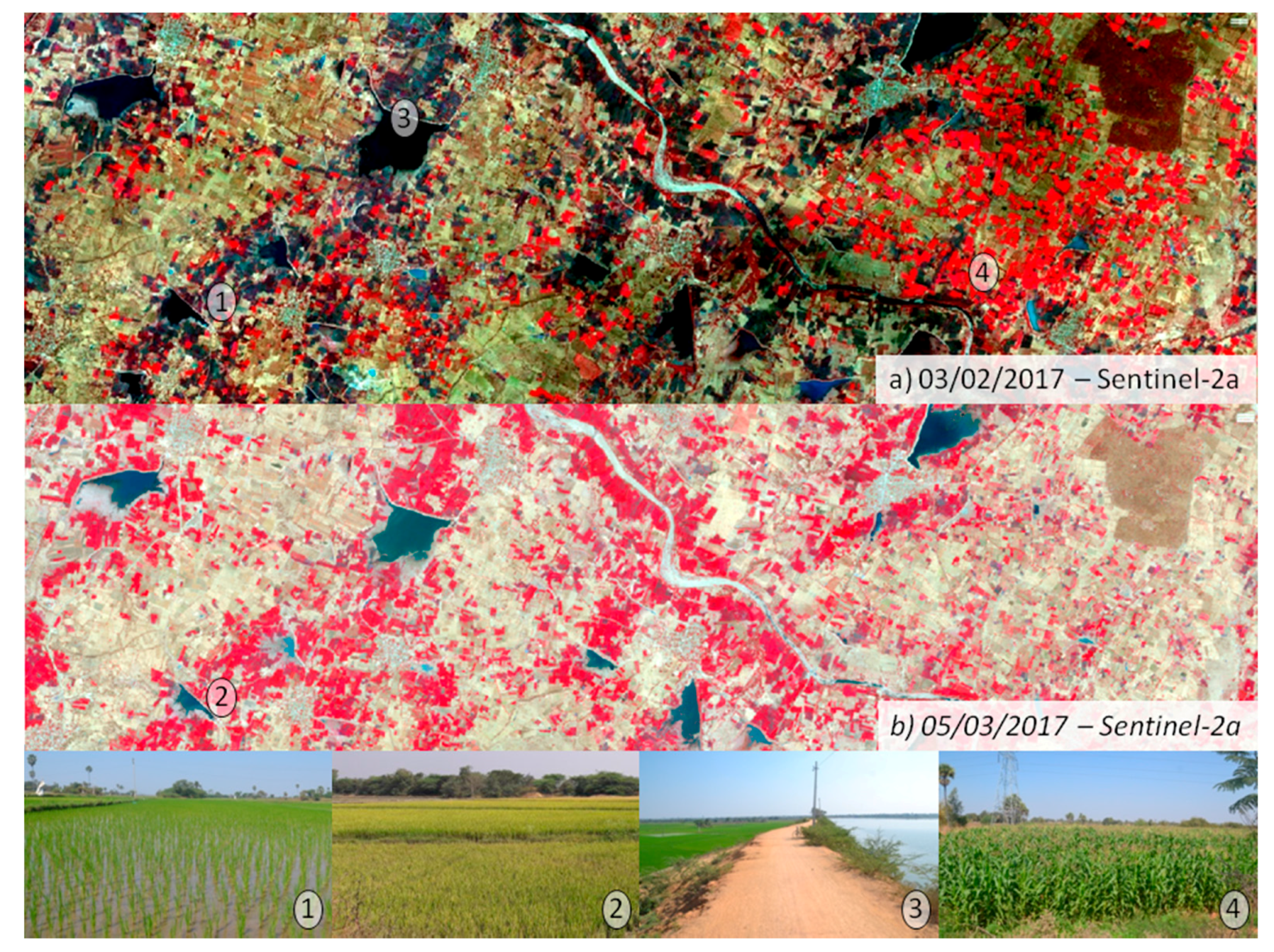

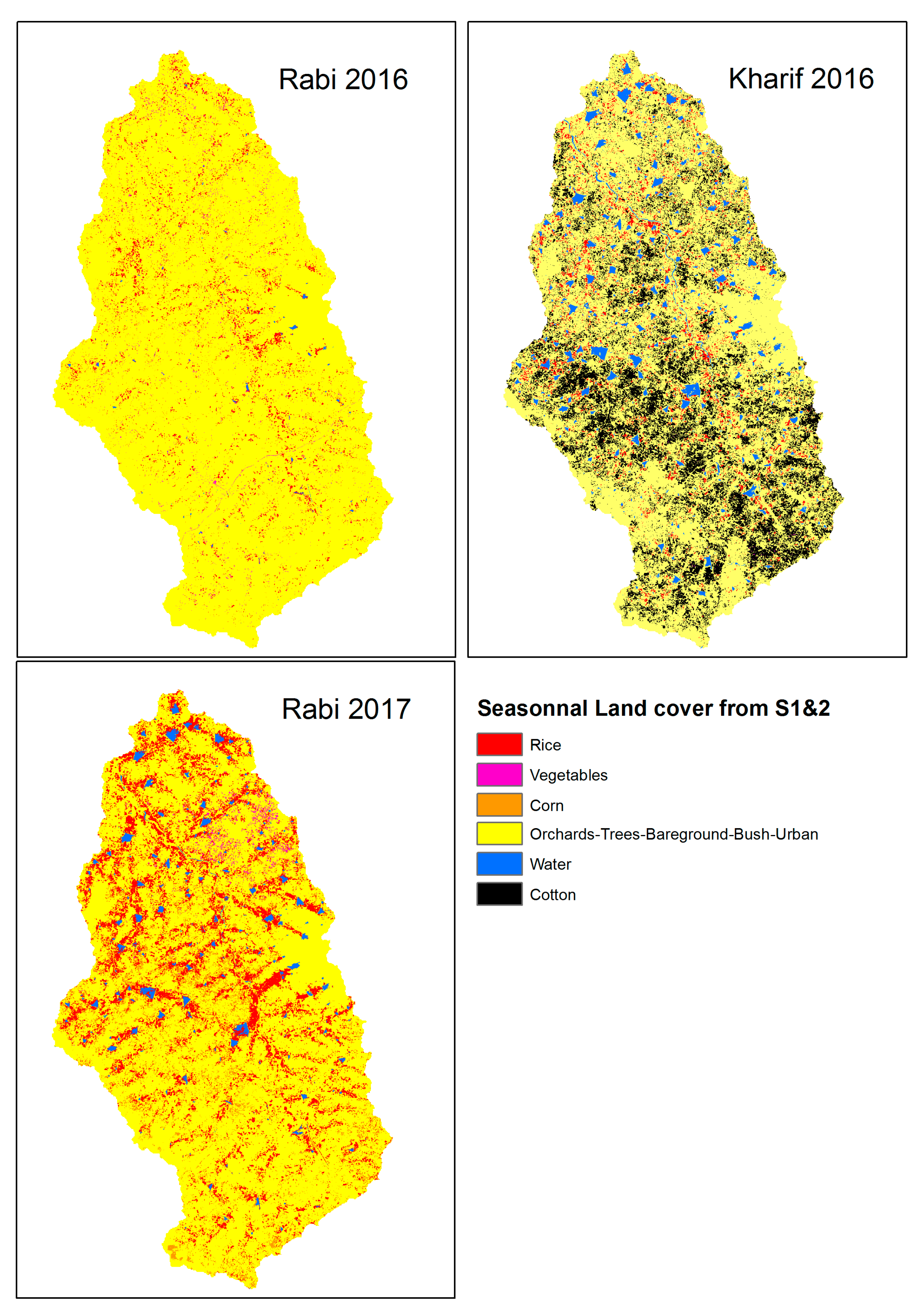
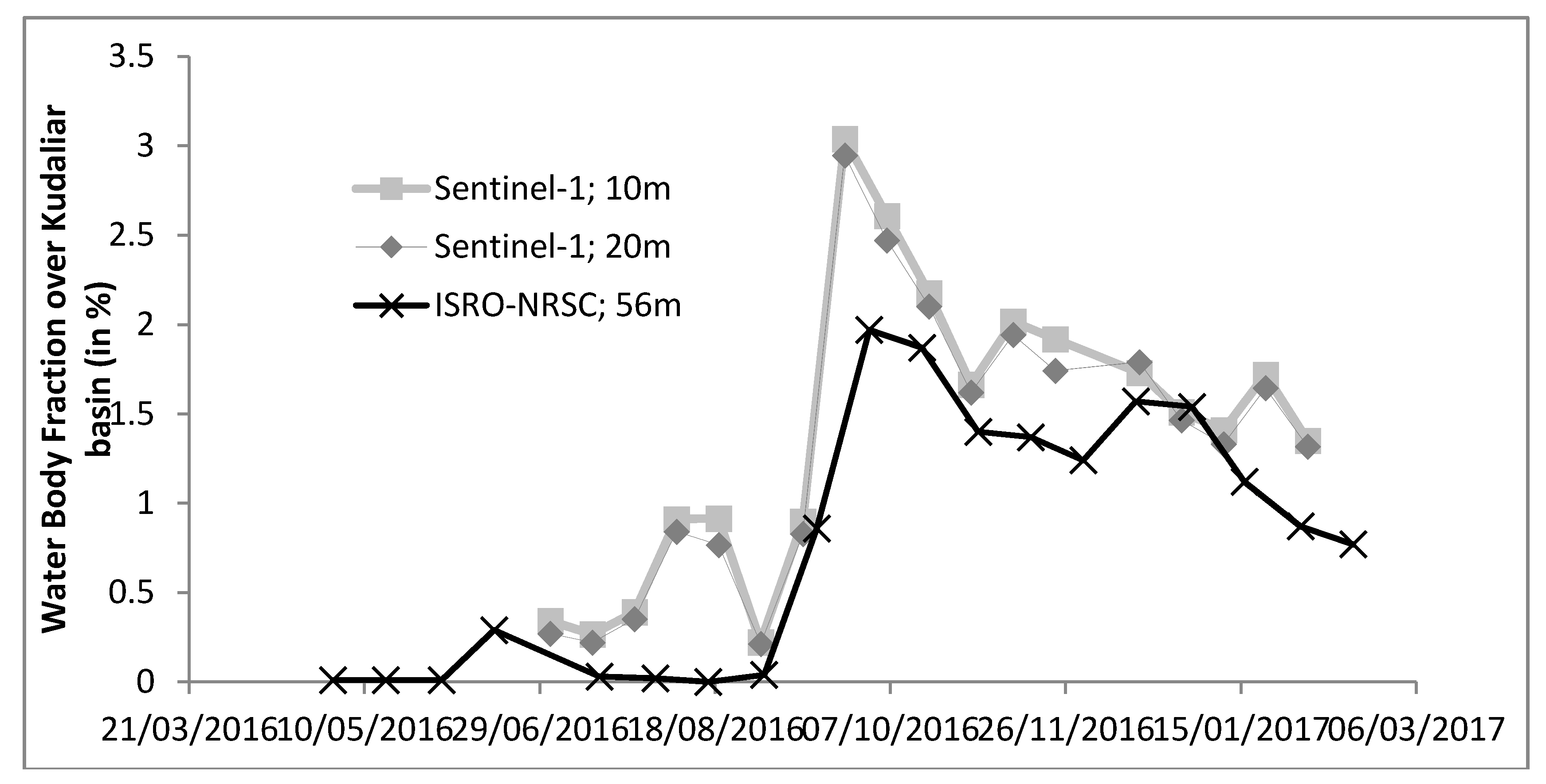
| Rabi 2016 | Kharif 2016 | Rabi 2017 | |||
|---|---|---|---|---|---|
| S1 | S2 Cloud-Free | S1 | S2 Cloud-Free | S1 | S2 Cloud-Free |
| 23/12/2015 | 31/12/2015 | 08/06/2016 | 28/07/2016 | 17/12/2017 | 05/12/2016 |
| 04/01/2016 | 26/01/2016 | 02/07/2016 | 26/10/2016 | 29/12/2017 | 15/12/2016 |
| 16/01/2016 | 30/01/2016 | 14/07/2016 | 25/11/2016 | 10/01/2017 | 25/12/2016 |
| 09/02/2016 | 09/02/2016 | 26/07/2016 | 05/12/2016 | 22/01/2017 | 24/01/2017 |
| 21/02/2016 | 19/02/2016 | 07/08/2016 | 03/02/2017 | 03/02/2017 | |
| 04/03/2016 | 10/03/2016 | 19/08/2016 | 23/02/2017 | ||
| 09/04/2016 | 31/08/2016 | 05/03/2017 | |||
| 19/04/2016 | 12/09/2016 | ||||
| 29/04/2016 | 24/09/2016 | ||||
| 06/10/2016 | |||||
| 18/10/2016 | |||||
| 30/10/2016 | |||||
| 11/11/2016 | |||||
| 23/11/2016 | |||||
| Class | Rabi 2016 | Kharif 2016 | Rabi 2017 |
|---|---|---|---|
| Rice | 1281 | 113 | 3191 |
| Vegetables | 937 | 24 | 262 |
| Maize | 720 | 76 | 617 |
| Orchards | 3615 | 2534 | 525 |
| Forested | 12,829 | 9583 | 8992 |
| Bare ground | 30,960 | 618 | 2819 |
| Urban | 2688 | 8008 | 9091 |
| Water | 79 | 385 | 841 |
| Cotton | 1905 |
| Sensor | Sentinel-1 | Sentinel-2 | Sentinel-1&2 | ||||||||||||||||
|---|---|---|---|---|---|---|---|---|---|---|---|---|---|---|---|---|---|---|---|
| Resolution | 10 | 20 | 10 | 20 | 10 | 20 | |||||||||||||
| Class | Season | Rabi 2016 | Kharif 2016 | Rabi 2017 | Rabi 2016 | Kharif 2016 | Rabi 2017 | Rabi 2016 | Kharif 2016 | Rabi 2017 | Rabi 2016 | Kharif 2016 | Rabi 2017 | Rabi 2016 | Kharif 2016 | Rabi 2017 | Rabi 2016 | Kharif 2016 | Rabi 2017 |
| Flooded Rice | Precision | 0.81 | 1 | 0.89 | 0.81 | 1 | 0.99 | 0.86 | 0.94 | 0.99 | 0.91 | 1 | 0.99 | 0.87 | 1 | 0.99 | 0.9 | 1 | 0.99 |
| Recall | 0.5 | 0.29 | 0.95 | 0.44 | 0.2 | 0.97 | 0.79 | 0.46 | 0.96 | 0.82 | 0.46 | 0.96 | 0.84 | 0.38 | 0.96 | 0.83 | 0.43 | 0.97 | |
| F-score | 0.62 | 0.45 | 0.92 | 0.57 | 0.33 | 0.98 | 0.82 | 0.62 | 0.97 | 0.86 | 0.63 | 0.98 | 0.86 | 0.56 | 0.98 | 0.87 | 0.6 | 0.98 | |
| Irrigated | Precision | 0.24 | 0 | 0.15 | 0.36 | 0 | 0.82 | 0.14 | 0 | 0.88 | 0.33 | 0 | 0.79 | 0.19 | 0 | 0.83 | 0.3 | 0 | 0.82 |
| Maize | Recall | 0.03 | 0 | 0.12 | 0.04 | 0 | 0.93 | 0.018 | 0 | 0.26 | 0.03 | 0 | 0.97 | 0.23 | 0 | 0.86 | 0.03 | 0 | 0.93 |
| Vegetables | F-score | 0.06 | 0 | 0.13 | 0.07 | 0 | 0.87 | 0.03 | 0 | 0.4 | 0.06 | 0 | 0.87 | 0.04 | 0 | 0.85 | 0.05 | 0 | 0.87 |
| Rainfed | Precision | - | 0.98 | - | - | 0.97 | - | - | 0.79 | - | - | 0.84 | - | - | 0.97 | - | - | 0.93 | - |
| Cotton | Recall | - | 0.92 | - | - | 0.91 | - | - | 0.68 | - | - | 0.73 | - | - | 0.86 | - | - | 0.91 | - |
| F-score | - | 0.95 | - | - | 0.94 | - | - | 0.73 | - | - | 0.78 | - | - | 0.91 | - | - | 0.92 | - | |
| Overall | Kappa | 0.3 | 0.5 | 0.39 | 0.29 | 0.49 | 0.76 | 0.36 | 0.79 | 0.68 | 0.42 | 0.86 | 0.78 | 0.41 | 0.85 | 0.59 | 0.42 | 0.91 | 0.76 |
| Technical | Nb dates | 6 | 14 | 5 | 6 | 14 | 5 | 9 | 4 | 7 | 9 | 4 | 7 | 15 | 18 | 12 | 15 | 18 | 12 |
| Details | Nb bands | 18 | 42 | 15 | 18 | 42 | 15 | 45 | 20 | 35 | 99 | 88 | 77 | 63 | 62 | 50 | 117 | 130 | 92 |
| Size Go | 16.6 | 38.7 | 13.8 | 4.1 | 9.5 | 3.5 | 41.5 | 18.4 | 32.2 | 22.8 | 57 | 17.7 | 58 | 57.1 | 46.1 | 26.9 | 66.5 | 21.2 | |
| Sensor | Sentinel-1 | Sentinel-2 | Sentinel-1&2 | ||||||||||||||||
|---|---|---|---|---|---|---|---|---|---|---|---|---|---|---|---|---|---|---|---|
| Resolution | 10 | 20 | 10 | 20 | 10 | 20 | |||||||||||||
| Class | Season | Rabi 2016 | Kharif 2016 | Rabi 2017 | Rabi 2016 | Kharif 2016 | Rabi 2017 | Rabi 2016 | Kharif 2016 | Rabi 2017 | Rabi 2016 | Kharif 2016 | Rabi 2017 | Rabi 2016 | Kharif 2016 | Rabi 2017 | Rabi 2016 | Kharif 2016 | Rabi 2017 |
| Flooded (%-ha) | 1.77–1739 | 2.3–2261 | 26.05–25,607 | 1.55–1523 | 2.37–2329 | 26.16–25,715 | 3.43–3371 | 5.13–5042 | 16.3–16,022 | 3.42–3361 | 6.1–5996 | 16.25–15,973 | 3.52–3460 | 4.49–4413 | 17.11–16,819 | 3.52–3460 | 5.06–4974 | 16.06–15,787 | |
| Agro-Hydrological | Irrigated (%-ha) | 0.65–639 | 0.24–236 | 2.11–2074 | 0.4–393 | 0.01–9.83 | 1.43–1405 | 2.77–2722 | 0.76–747 | 6.3–6192 | 2.13–2093 | 0.52–511 | 6.74–6625 | 1.74–1710 | 0.58–570 | 6.4–6291 | 1.9–1867 | 0.05–49.15 | 6.93–6812 |
| variables | Cotton (%-ha) | 20.7–20,348 | 21.02–20,662 | 16.17–15,895 | 21.76–21,390 | 19.5–19,168 | 20.73–20,377 | ||||||||||||
| Water Demand (Rice-others) mm | 23–1.44 | 21.4–0.52 | 337.6–4.42 | 20.2–0.9 | 22–0.03 | 338.8–3 | 44.54–5.99 | 47.6–1.7 | 212–13.39 | 44.38–4.29 | 56.5–1.13 | 210.5–14.1 | 45.6–3.75 | 41.6–1.25 | 222–13.48 | 45.7–4.1 | 46.9–0.12 | 208–14.5 | |
© 2017 by the authors. Licensee MDPI, Basel, Switzerland. This article is an open access article distributed under the terms and conditions of the Creative Commons Attribution (CC BY) license (http://creativecommons.org/licenses/by/4.0/).
Share and Cite
Ferrant, S.; Selles, A.; Le Page, M.; Herrault, P.-A.; Pelletier, C.; Al-Bitar, A.; Mermoz, S.; Gascoin, S.; Bouvet, A.; Saqalli, M.; et al. Detection of Irrigated Crops from Sentinel-1 and Sentinel-2 Data to Estimate Seasonal Groundwater Use in South India. Remote Sens. 2017, 9, 1119. https://doi.org/10.3390/rs9111119
Ferrant S, Selles A, Le Page M, Herrault P-A, Pelletier C, Al-Bitar A, Mermoz S, Gascoin S, Bouvet A, Saqalli M, et al. Detection of Irrigated Crops from Sentinel-1 and Sentinel-2 Data to Estimate Seasonal Groundwater Use in South India. Remote Sensing. 2017; 9(11):1119. https://doi.org/10.3390/rs9111119
Chicago/Turabian StyleFerrant, Sylvain, Adrien Selles, Michel Le Page, Pierre-Alexis Herrault, Charlotte Pelletier, Ahmad Al-Bitar, Stéphane Mermoz, Simon Gascoin, Alexandre Bouvet, Mehdi Saqalli, and et al. 2017. "Detection of Irrigated Crops from Sentinel-1 and Sentinel-2 Data to Estimate Seasonal Groundwater Use in South India" Remote Sensing 9, no. 11: 1119. https://doi.org/10.3390/rs9111119




